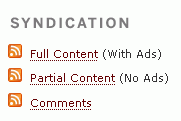We took a long look at the features U.S. newspapers include on their websites a few weeks back. In doing the research, we spent more time than is healthy looking at these things. So we figured we’d use this new found expertise for good and offer the newspaper industry some unsolicited advice on how to improve their websites.
(1) Start Using Tags. The structure of just about every site we looked at more or less followed that of the paper’s print edition. This is great if you are looking to read the print version of the paper but not great if you are looking to see everything the paper has written on, say, Joe Lieberman. Newspapers aren’t taking advantage of the opportunity the Internet offers to remix/categorize content.
The social news site Newsvine uses tags, and all I have to do is put in newsvine.com/lieberman and voila, I see all the Lieberman stories. Using tags to complement traditional navigation is a great way to offer alternative views of content and better relate stories to each other.
The taxonomy of newspaper sites is broken and using tags is a pretty good way to start fixing the problem.
 (2) Provide Full Text RSS Feeds. Not a single newspaper we looked at offered full text RSS feeds. All of them only offered partial feeds, essentially using RSS like email notification – letting users know about new stuff in order to attract more page views. Newspaper should experiment with providing ad-supported full text RSS feeds. This is already common practice among blogs like Gawker (see right) and would satisfy the growing number of folks who want to read all their news in a single RSS reader.
(2) Provide Full Text RSS Feeds. Not a single newspaper we looked at offered full text RSS feeds. All of them only offered partial feeds, essentially using RSS like email notification – letting users know about new stuff in order to attract more page views. Newspaper should experiment with providing ad-supported full text RSS feeds. This is already common practice among blogs like Gawker (see right) and would satisfy the growing number of folks who want to read all their news in a single RSS reader.
(3) Work with External “Social” Websites. Only four of the hundred websites we looked at allowed bookmarking through social bookmarking sites like del.icio.us. And to my knowledge none allowed for easy submission of content to Digg from their website. Newspapers should work with sites like these as a way to promote and spread their content.
 (4) Link to Relevant Blog Entries. Sites like the Washington Post are already partnering with Technorati to show “Who’s Blogging” about the story you are viewing (see left). Why bother? If I’m a blogger writing about a news event, I’m going to link to the Post story as a way of promoting my entry. It is a great way to facilitate discussion about (and links to) your content. In addition, the “Who’s Blogging” feature serves as a real time letters to the editor page.
(4) Link to Relevant Blog Entries. Sites like the Washington Post are already partnering with Technorati to show “Who’s Blogging” about the story you are viewing (see left). Why bother? If I’m a blogger writing about a news event, I’m going to link to the Post story as a way of promoting my entry. It is a great way to facilitate discussion about (and links to) your content. In addition, the “Who’s Blogging” feature serves as a real time letters to the editor page.
(5) Get Rid of All Registration. I’m at the point where I’m not going to register to read content unless it’s the New York Times. I’ll either work around the registration using BugMeNot or just go elsewhere. Registration prevents your content from being discussed and spreading online. It hurts page views too.
(6) Partner with Local Bloggers. Lots of newspapers have their own blogs with content provided by overworked reporters. The quality of these blogs varies wildly from site to site. Why not partner with popular local bloggers and create a “best of” blog feed for your city/region? This seems like a good way to liven up your content and establish deep ties with bloggers in your region.
(7) Offer Alternative Views of Your Content. Editors are great gatekeepers and play an important function. But on the web why not give us a look at your homepage showing the most read stories? Or most blogged? Or even allow Digg style voting and show the stories with the most votes? I’m not advocating abandoning the concept of editors and going fully to a social model, but why not give people some choices as to how they look at your content? Alternatively, partner with a social news site like Reddit and let them create an alternative view of your homepage for you. Slate did.
(8) Modernize Your Site’s Graphic Design. Most of the newspaper sites we looked at had designs straight out of 2001. They used half of the screen real estate available on today’s wide screen monitors and looked sort of like online swap meets. The New York Times and Austin American Statesman are examples of sites with good, modern designs.
(9) Learn from Craigslist. In our study we didn’t look much at the Classified sections of the websites. But from what I’ve seen, newspapers could learn lots of lessons by looking at the efficient way Craigslist presents its content. Like Google, it’s brilliant because it is simple. Classified sections on newspapers sites are neither.
What do you think? How do you think newspapers can improve their sites?
Update 1: Forgot one.
(10) Make your content work on cell phones and PDAs. Sixteeen of the twenty one largest Japanese newspaper offer versions of their paper that work on a cell phone. I don’t think a single US paper includes this option, although Dave Winer has helped some sites out and put together mobile-friendly versions of a few papers as a public service.
Update 2: I did another post building on the list based on comments by readers.
Sign up today to have our latest posts delivered straight to your inbox.